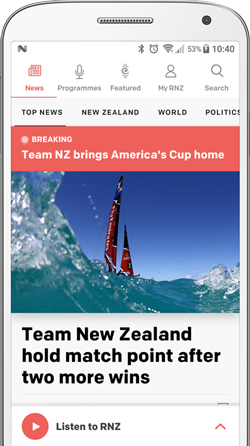
Weddell seal pup. Photo: Arek Aspinwall / Permit ACA 2025-010
Follow Wild Sounds: Voice of the Sea Ice on Apple, Spotify, iHeartRadio or wherever you listen to your podcasts
In July 1911, it took Apsley Cherry-Garrard, Edward Wilson and Henry Bowers 19 days to travel from Cape Evans to the emperor penguin rookery at Cape Crozier.
Pulling sleds first across the sea ice of McMurdo Sound, and then across the Ross Ice Shelf, in pitch black darkness, and bitingly cold temperatures.
Their goal was to collect some emperor penguin eggs for science, but their experience was what inspired the name of Cherry-Garrard's memoir: The Worst Journey in the World.
Today, the trip from Scott Base to Cape Crozier takes just one hour by helicopter.

Rachel Hickcox with some Adélie penguins. Photo: Michelle LaRue
'Most badass animals in the world'
It's a trip that Dr Michelle LaRue of the University of Canterbury is happy to take, especially in the 24-hour sunlight of November 2024.
Cape Crozier, on the eastern end of Ross Island, is a special place, she says, inhabited by hundreds of thousands of Adélie penguins, up to 2,000 emperor penguins, and about 50 Weddell seals.
The emperor penguins use the sea ice as their nursery. In the middle of the dark and freezing winter, this is where they come to lay their eggs. Instead of nests, the egg is cared for on the feet of the male penguins, who huddle together against the winter cold.

Dr Michelle LaRue at Cape Crozier. Photo: K051 team member
It's something Michelle believes makes penguins particularly 'badass'.
"Antarctica is the highest, driest, windiest, coldest continent on the earth. And these are birds that come back to the continent to breed in the middle of wintertime when it's like the worst of all of those things," she says.
There are not many places where these seal and penguin predators hang out in close proximity. Michelle is interested in whether they have their own niches - dividing up the territory and food - or whether they compete for the same resources.

US and NZ science teams at Cape Crozier. Photo: Michelle LaRue
To investigate this, Michelle and her team are attaching satellite tags to ten each of the Adélie and emperor penguins, and to ten Weddell seals. The tags give real-time information on where the predators are going, and how deep they are diving.
Their initial results appear to show that her 'niche partitioning theory' is correct - they don't tend to overlap in the areas that they are fishing. But the team will be back next year to tag more birds and seals to gather sufficient data to be sure.
While there, they also collect seal whisker and penguin feather samples, as well as samples of the microalgae found on the bottom of the sea ice, plus some seal scat, or poo.

Emperor penguin tracks as at 20 February 2025. Photo: Michelle LaRue
These samples help them check the health of the animals and enable them to investigate where everybody sits on the who's-eating-who tiers of the Antarctic food web.
The seal scat is also scientific gold for another Antarctic researcher.
Meet the Scott Base seals
Just outside Scott Base, icy towers and bunched-up, folded-over sheets form where the sea ice squashes up against Ross Island. These structures provide shelter from the wind. Cracks through the ice allow access to the ocean below.

Arek Aspinwall at the pressure ridges outside Scott Base. Photo: Claire Concannon / RNZ
It's ideal for Weddell seals, explains University of Canterbury PhD candidate Arek Aspinwall. So ideal, in fact, they will raise newborn pups here.
"Weddell seals are really cool in that they can find all these cracks and holes and breathe and go under the sea ice, whereas the things that eat Weddell seals - like leopard seals and killer whales - they can't get this far into the sound at this time of year. So, these pups are pretty safe," Arek explains.
It's morning and many of the mums have gone fishing, fuelling up so they can produce milk for their rapidly growing pups. Adult Weddell seals reach 400-500 kg. When the pups are born, they weigh about 30 kg, but within six weeks will be up to around 100 kg.

Newborn pup. Photo: Arek Aspinwall / Permit ACA 2025-010
Monitoring stress with seal poo
Arek is out here daily to collect their scat and urine. He's investigating whether construction activities at nearby Scott Base are stressing the seals.
"We accept that we always have an impact. It's about weighing up the pros and the cons," he says.
"And this is why we have ethics committees and processes to go through to be like, you know what, if we want to have an Antarctic presence, we will disturb the environment to a certain degree and we need to figure out what's an acceptable amount and what's an acceptable impact."

Weddell seal. Photo: Arek Aspinwall / Permit ACA 2025-010
Back in Christchurch, Arek will analyse the seal poo and pee for the stress hormone cortisol. He will then sync up what he finds with different activities happening on base.
Samples from seals that live remote, far from any research bases - such as those hanging out with the penguins at Cape Crozier - will act as controls.
Using a timelapse camera, Arek will also investigate whether the Scott Base seals change their behaviour when construction is happening.

Weddell seal pup. Photo: Arek Aspinwall / Permit ACA 2025-010
As the sea ice retreats later in summer, so too do the Weddell seals. When the ice breaks up further out in the sound, the seals funnel down to the area around Scott Base, where the ice is last to go.
They show up in large numbers in January and February, and then when the ice starts to freeze again in March, they spread out once again.

Weddell seals at the pressure ridges outside Scott Base. Photo: Claire Concannon / RNZ
This series was made with travel support from the Antarctica New Zealand Community Engagement Programme.
Sign up to the Our Changing World monthly newsletter for episode backstories, science analysis and more.






